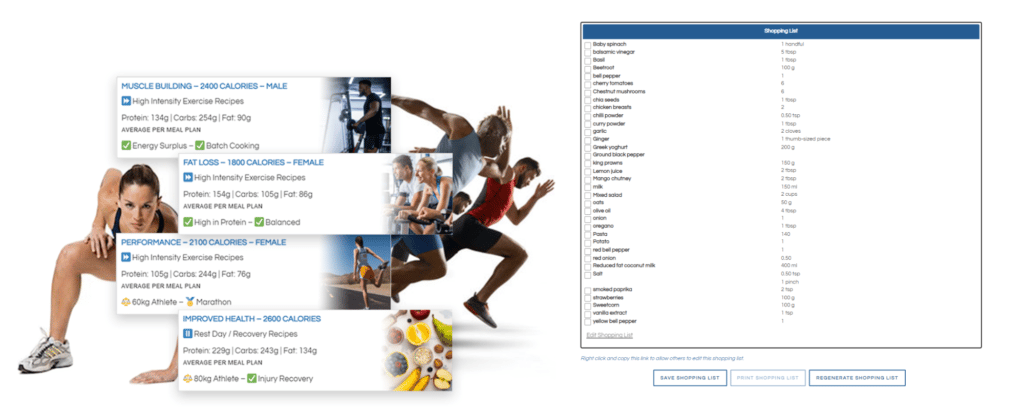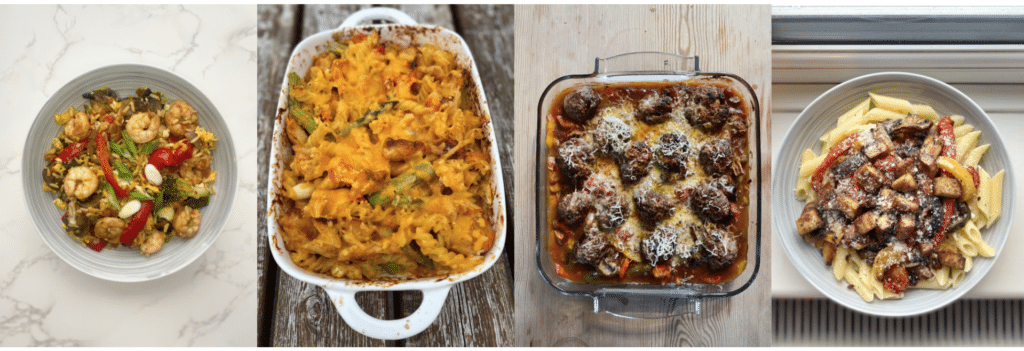Eating healthy doesn’t have to break the bank. With a few simple tips and tricks, you can enjoy delicious, nutritious meals while staying within your budget. It does require some planning and research, but with a bit of know-how, you can put together a meal plan that works for you and your budget.
Here are some tips to help you eat well without breaking the bank:

1. Plan your meals:
Make a shopping list and stick to it to avoid impulse purchases. Plan to cook at home as much as possible, as this will save you money and give you more control over the ingredients in your food. All of our meal plans allow you to create a shopping list which can make this process a lot easier.
Here’s some mid week recipe inspiration to kick things off!

2. Buy in bulk:
Buying non-perishable items like rice, beans, and pasta in bulk can save you money in the long run. Just make sure to store these items properly to keep them fresh.

3. Buy supermarket own brands:
Many supermarket own brands are just as good in quality without paying for the name. Mixing high quality products can sometimes cut down on the cost. For example, mixing Fage Greek yogurt with a cheaper supermarket own brand greek yogurt can help cut the cost and allow it to last for longer.

4. Leftovers for lunch:
Eating leftovers at home can help reduce cost and improve both your meal planning and food quality . For example, you can make large batches of food that can be stored in the fridge or freezer for later use. By preparing these meals ahead of time, you’ll save time and money by not having to buy additional ingredients for each individual meal. Additionally, you can portion out large batches into smaller containers for single-serving meals that you can take with you to work or school. This will also save you time in the morning, without need to make lunch every day.

5. Make your own meals:
Cooking from scratch at home is cheaper than eating out or buying pre-packaged meals. Plus, you have more control over the ingredients, so you can make sure you’re getting the nutrients you need. Check out our recipes to gain inspiration on meal ideas and add variety to your week!
Our meal plans can help you to create a system for your meals throughout the week. Check out this post on how our meal plans work and how to make them your own!

6. Don’t be afraid of frozen fruits and vegetables:
Frozen produce can be just as nutritious as fresh, and it’s often more affordable. Plus, it’s convenient to have on hand and doesn’t go bad as quickly. Frozen berries instead of fresh berries are often half the price with the same quality!
Using frozen berries for smoothies are super handy for pre and post training fuel!

7. Avoid pre-packaged meals where possible:
These types of foods are often more expensive and you’re in less control of the ingredients. Choose fresh, whole foods whenever possible.

8. Grow your own:
While it’s not for everyone and of course requires quite the commitment, If you have a little bit of outdoor space, consider starting a small garden to grow your own vegetables. This can be a fun and rewarding way to save money and add more fruit and veg to your diet.
My parents started growing their own vegetables in lockdown. I was living in Asia for 2 years and came home to find the garden where I had grown up playing football had been turned into a vegetable garden. What started as something to pass time, became a balance of passion and frustration for my dad. Figuring out which vegetables needed more attention than others, with some even growing like weeds, such as kumquat. They grew carrots, beetroot, cabbage, peas, tomatoes, sweetcorn, scallions, lettuce, apples, red & black currants, strawberries, and even herbs like parsley, rosemary, thyme & mint which my mum uses for soups. It was inspiring to watch!
By following these tips and being mindful of your food choices, you can certainly eat healthy on a budget.
Our lifetime recipes can be the help you need to stay on top of your diet and your budget!










